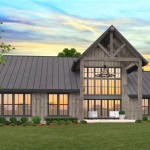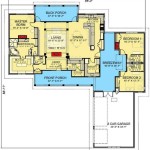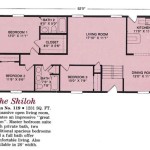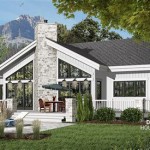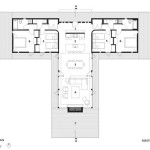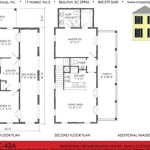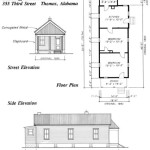Contemporary lakefront house plans are architectural designs tailored to the unique demands of waterfront living. They prioritize seamless indoor-outdoor transitions, maximizing natural light, and capitalizing on breathtaking lakefront views. An exemplary illustration of such a plan is the recently constructed residence on Lake Tahoe’s shores. Its expansive windows frame panoramic vistas across the crystal-clear waters, while its open floor plan fosters a constant connection with the surrounding landscape.
These plans consider both aesthetics and functionality. They incorporate elements that enhance the waterfront experience, such as expansive decks or patios for outdoor relaxation, dedicated boathouses or docks for watercraft enthusiasts, and well-defined outdoor living spaces for al fresco dining and entertaining.
In the following sections, we will delve deeper into the intricacies of contemporary lakefront house plans, exploring their defining characteristics, key considerations, and innovative design solutions that cater to the discerning tastes of modern waterfront homeowners.
Contemporary lakefront house plans prioritize the following key considerations:
- Expansive windows and natural light
- Open floor plans
- Indoor-outdoor transitions
- Waterfront orientation
- Outdoor living spaces
- Energy efficiency
- Sustainability
- Modern aesthetics
- Customization
These elements combine to create lakefront homes that are both stylish and functional, offering a seamless and enjoyable living experience by the water.
Expansive windows and natural light
Expansive windows are a defining characteristic of contemporary lakefront house plans. They serve multiple purposes, enhancing the overall living experience in the following ways:
- Maximize natural light: Large windows allow abundant natural light to flood the interior, creating a bright and airy atmosphere. This reduces the need for artificial lighting, saving energy and enhancing the connection to the outdoors.
- Stunning views: Floor-to-ceiling windows or expansive window walls provide unobstructed views of the lake and surrounding landscape. Homeowners can enjoy the beauty of their waterfront surroundings from the comfort of their living spaces.
- Indoor-outdoor connection: Expansive windows blur the boundaries between indoor and outdoor living. They create a seamless transition between the interior and exterior, allowing homeowners to feel connected to nature while enjoying the comforts of their home.
- Improved well-being: Natural light has been shown to have a positive impact on mood, productivity, and overall well-being. By incorporating expansive windows, lakefront homeowners can benefit from the mood-boosting and energizing effects of natural light.
In addition to the benefits listed above, expansive windows also contribute to the overall aesthetic appeal of the home. They create a modern and sophisticated look that complements the natural beauty of the waterfront setting.
Open floor plans
Open floor plans are a defining feature of contemporary lakefront house plans. They offer a number of advantages that make them ideal for waterfront living:
- Spaciousness and flexibility: Open floor plans eliminate traditional walls between living spaces, creating a more spacious and expansive feel. This allows for greater flexibility in furniture arrangement and makes it easier to accommodate large gatherings.
- Enhanced natural light: By removing walls, open floor plans allow natural light to penetrate deeper into the home. This creates a brighter and more inviting living environment.
- Improved views: Open floor plans often incorporate large windows and expansive window walls. This provides unobstructed views of the lake and surrounding landscape from multiple vantage points within the home.
- Seamless indoor-outdoor transitions: Open floor plans facilitate a seamless connection between indoor and outdoor living spaces. This makes it easy for homeowners to transition from the interior of the home to outdoor decks, patios, or balconies, enhancing the overall living experience.
In addition to these advantages, open floor plans also contribute to the overall modern aesthetic of contemporary lakefront homes. They create a sense of spaciousness and openness that is highly sought after by today’s homeowners.
Indoor-outdoor transitions
Indoor-outdoor transitions are a key design element in contemporary lakefront house plans. They create a seamless connection between the interior and exterior of the home, allowing homeowners to fully enjoy their waterfront surroundings.
- Floor-to-ceiling windows and doors: Floor-to-ceiling windows and doors are a popular way to achieve seamless indoor-outdoor transitions. These large openings allow for expansive views of the lake and surrounding landscape, and they make it easy to transition between the interior and exterior living spaces.
- Expansive decks and patios: Decks and patios are essential for outdoor living, and they are often incorporated into contemporary lakefront house plans. These outdoor spaces provide a place to relax, entertain guests, or simply enjoy the views. They can be furnished with comfortable seating, dining tables, and grills, creating a true extension of the home’s living space.
- Screened-in porches: Screened-in porches offer a protected outdoor living space that is free from insects and other pests. They can be furnished with comfortable seating and dining areas, and they can be used for year-round enjoyment.
- Walk-out basements: Walk-out basements provide direct access to the outdoors from the lower level of the home. They can be used to create additional living space, such as a family room or guest suite, and they can also be used to access outdoor patios or decks.
By incorporating these design elements, contemporary lakefront house plans create homes that are both stylish and functional. They allow homeowners to maximize their enjoyment of their waterfront property and to create a truly indoor-outdoor living experience.
Waterfront orientation
Waterfront orientation is a critical consideration in contemporary lakefront house plans. It refers to the way the home is positioned on the lot in relation to the lake. The goal is to maximize the views of the lake and to create a seamless connection between the interior and exterior of the home.
- Maximize views: The best lakefront house plans are oriented to take advantage of the views of the lake. This means positioning the home so that the main living areas, such as the living room, dining room, and master bedroom, have unobstructed views of the water. Floor-to-ceiling windows and expansive window walls can be used to further enhance the views.
- Create outdoor living spaces: Waterfront orientation also involves creating outdoor living spaces that take advantage of the lake views. This can be done by incorporating decks, patios, or screened-in porches that are positioned to maximize the views of the lake. These outdoor living spaces can be used for relaxing, entertaining guests, or simply enjoying the beauty of the waterfront setting.
- Consider sunlight: In addition to views, it is also important to consider sunlight when orienting the home on the lot. The goal is to position the home so that it receives plenty of natural light throughout the day. This can be done by orienting the home so that the main living areas face south or west. This will allow for maximum sunlight to enter the home during the day.
- Minimize wind exposure: If the lake is known for strong winds, it is important to consider wind exposure when orienting the home on the lot. The goal is to position the home so that it is protected from the wind. This can be done by orienting the home so that the main living areas are not facing directly into the wind.
By carefully considering waterfront orientation, contemporary lakefront house plans can create homes that are both stylish and functional. They can maximize the views of the lake, create seamless indoor-outdoor transitions, and take advantage of natural light and protection from the elements.
Outdoor living spaces
Outdoor living spaces are an essential part of contemporary lakefront house plans. They allow homeowners to enjoy the beauty of their waterfront property and to create a truly indoor-outdoor living experience. There are a number of different types of outdoor living spaces that can be incorporated into a lakefront home, including decks, patios, screened-in porches, and walk-out basements.
- Decks: Decks are a popular choice for outdoor living spaces because they are relatively easy to build and can be customized to fit the specific needs of the homeowner. Decks can be built using a variety of materials, including wood, composite, and vinyl. They can be designed to be either open or covered, and they can be furnished with comfortable seating, dining tables, and grills.
- Patios: Patios are another popular choice for outdoor living spaces. They are typically made of concrete or pavers, and they can be designed to be either open or covered. Patios are a good choice for homeowners who want a more permanent outdoor living space that is easy to maintain. They can be furnished with comfortable seating, dining tables, and grills, and they can also be used for entertaining guests.
- Screened-in porches: Screened-in porches offer a protected outdoor living space that is free from insects and other pests. They can be furnished with comfortable seating and dining areas, and they can be used for year-round enjoyment. Screened-in porches are a good choice for homeowners who want to enjoy the outdoors without having to worry about bugs.
- Walk-out basements: Walk-out basements provide direct access to the outdoors from the lower level of the home. They can be used to create additional living space, such as a family room or guest suite, and they can also be used to access outdoor patios or decks. Walk-out basements are a good choice for homeowners who want to maximize their use of their waterfront property.
By incorporating outdoor living spaces into their home plans, contemporary lakefront homeowners can create a truly indoor-outdoor living experience. They can enjoy the beauty of their waterfront property, relax in the fresh air, and entertain guests in style.
Energy efficiency
Energy efficiency is an important consideration in contemporary lakefront house plans. By incorporating energy-efficient features into their homes, homeowners can reduce their energy consumption and save money on their utility bills. There are a number of different energy-efficient features that can be incorporated into a lakefront home, including:
- Energy-efficient windows and doors: Energy-efficient windows and doors are designed to minimize heat loss and gain. They typically feature double- or triple-pane glass, and they may also have a special coating that reflects heat. Energy-efficient windows and doors can help to reduce the amount of energy needed to heat and cool the home.
- Insulation: Insulation is a material that is used to reduce heat transfer. It can be installed in the walls, ceiling, and floor of the home. Insulation helps to keep the home warm in the winter and cool in the summer, which can reduce the amount of energy needed to heat and cool the home.
- Energy-efficient appliances: Energy-efficient appliances use less energy to operate than traditional appliances. Look for appliances with the Energy Star label, which indicates that the appliance meets certain energy-efficiency standards. Energy-efficient appliances can help to reduce the amount of energy consumed in the home.
- Renewable energy sources: Renewable energy sources, such as solar and wind power, can be used to generate electricity and heat for the home. By incorporating renewable energy sources into their home, homeowners can reduce their reliance on fossil fuels and save money on their energy bills.
In addition to these specific features, contemporary lakefront house plans can also incorporate passive design strategies to improve energy efficiency. Passive design strategies take advantage of natural elements, such as sunlight, shade, and wind, to reduce the need for energy consumption. For example, a home can be oriented to take advantage of passive solar heating, which uses the sun’s heat to warm the home in the winter. By incorporating energy-efficient features and passive design strategies, contemporary lakefront house plans can create homes that are both stylish and sustainable.
Sustainability
Sustainability is a key consideration in contemporary lakefront house plans. By incorporating sustainable features into their homes, homeowners can reduce their environmental impact and create a healthier living environment for themselves and their families. There are a number of different sustainable features that can be incorporated into a lakefront home, including:
- Sustainable building materials: Sustainable building materials are materials that are produced in a way that minimizes environmental impact. They include recycled materials, renewable resources, and materials that are produced locally. Sustainable building materials can help to reduce the amount of waste generated during construction and can also help to reduce the home’s carbon footprint.
- Water conservation: Water conservation is an important consideration for lakefront homeowners. By incorporating water-saving features into their homes, homeowners can reduce their water consumption and help to protect the lake ecosystem. Water-saving features include low-flow toilets, faucets, and showerheads, as well as rain barrels and cisterns for collecting rainwater.
- Energy efficiency: Energy efficiency is another important consideration for sustainable lakefront homes. By incorporating energy-efficient features into their homes, homeowners can reduce their energy consumption and save money on their utility bills. Energy-efficient features include energy-efficient windows and doors, insulation, and energy-efficient appliances.
- Renewable energy sources: Renewable energy sources, such as solar and wind power, can be used to generate electricity and heat for the home. By incorporating renewable energy sources into their home, homeowners can reduce their reliance on fossil fuels and save money on their energy bills.
In addition to these specific features, contemporary lakefront house plans can also incorporate passive design strategies to improve sustainability. Passive design strategies take advantage of natural elements, such as sunlight, shade, and wind, to reduce the need for energy consumption. For example, a home can be oriented to take advantage of passive solar heating, which uses the sun’s heat to warm the home in the winter. By incorporating sustainable features and passive design strategies, contemporary lakefront house plans can create homes that are both stylish and sustainable.
Modern aesthetics
Contemporary lakefront house plans embrace modern aesthetics, characterized by clean lines, simple forms, and a focus on natural materials. This aesthetic is achieved through the use of the following design elements:
Clean lines and simple forms: Modern lakefront homes feature clean lines and simple forms. This creates a sleek and sophisticated look that is both timeless and contemporary. Avoid unnecessary ornamentation or embellishments, and instead opt for simple, geometric shapes.
Natural materials: Natural materials, such as wood, stone, and glass, are commonly used in modern lakefront house plans. These materials bring a sense of warmth and organic beauty to the home, and they also help to connect the home to its natural surroundings. Wood can be used for siding, decking, and interior paneling. Stone can be used for fireplaces, countertops, and exterior cladding. Glass can be used for windows, doors, and railings.
Open floor plans: Open floor plans are a hallmark of modern lakefront house plans. They create a spacious and airy feel, and they allow for a seamless flow of indoor and outdoor living. Open floor plans are ideal for entertaining guests and for enjoying the lake views.
Large windows and doors: Large windows and doors are another key feature of modern lakefront house plans. They provide expansive views of the lake and the surrounding landscape, and they help to bring the outdoors in. Large windows and doors can be used in the living room, dining room, and master bedroom.
Customization
Customization is a key consideration in contemporary lakefront house plans. Homeowners want their homes to reflect their unique style and needs, and they are increasingly looking for plans that can be customized to their specific requirements. Contemporary lakefront house plans offer a wide range of customization options, including the ability to:
- Choose the size and layout of the home: Contemporary lakefront house plans are available in a variety of sizes and layouts, from small cabins to large luxury homes. Homeowners can choose the size and layout that best suits their needs and budget.
- Select the exterior and interior finishes: Contemporary lakefront house plans offer a variety of exterior and interior finishes to choose from, including siding, roofing, windows, doors, flooring, and cabinetry. Homeowners can select the finishes that best suit their taste and style.
- Add or remove features: Contemporary lakefront house plans can be customized to include or remove specific features, such as decks, patios, screened-in porches, fireplaces, and garages. Homeowners can choose the features that are most important to them and their families.
- Work with an architect to create a custom plan: For homeowners who want a truly unique home, they can work with an architect to create a custom plan. This allows homeowners to have complete control over the design of their home, from the size and layout to the exterior and interior finishes.
By offering a wide range of customization options, contemporary lakefront house plans allow homeowners to create homes that are uniquely their own. Whether they are looking for a small cabin or a large luxury home, homeowners can find a plan that meets their needs and budget.









Related Posts

